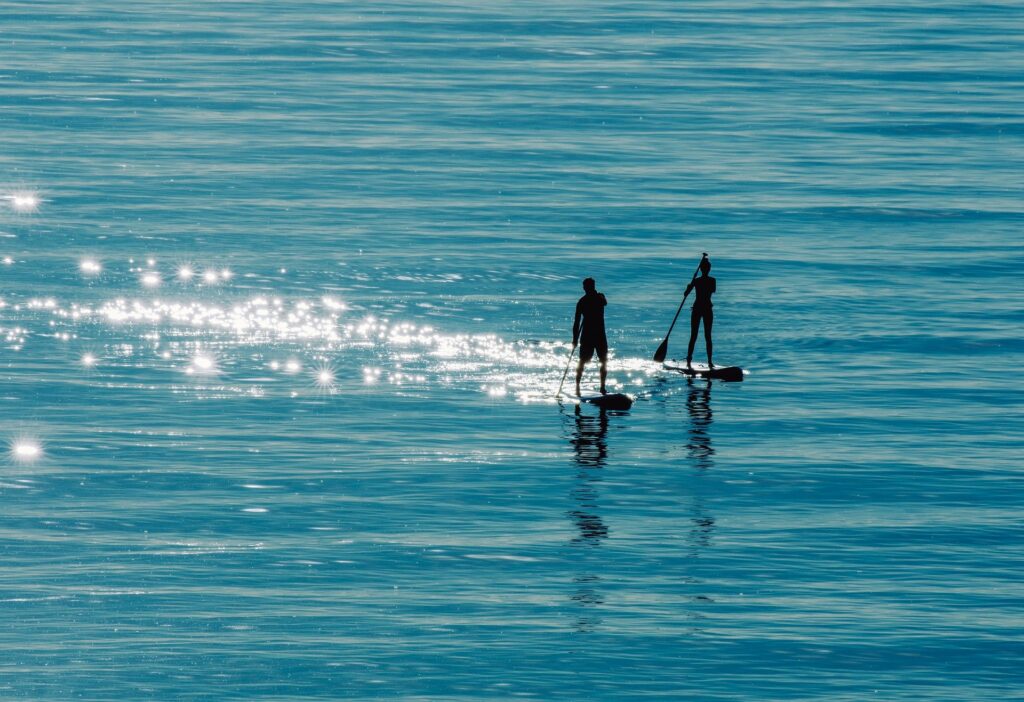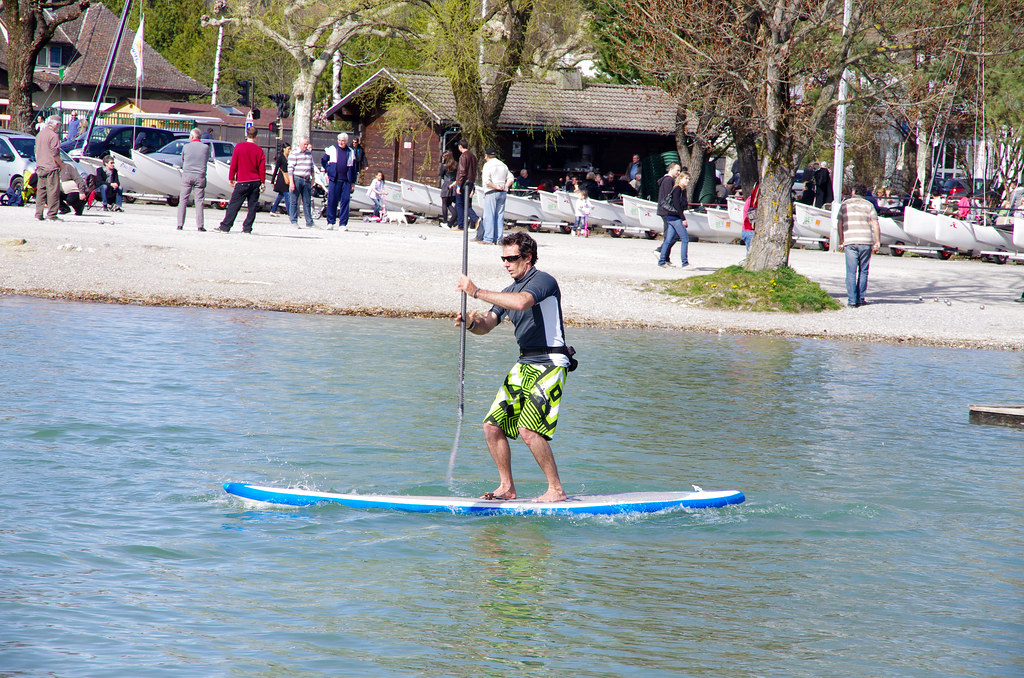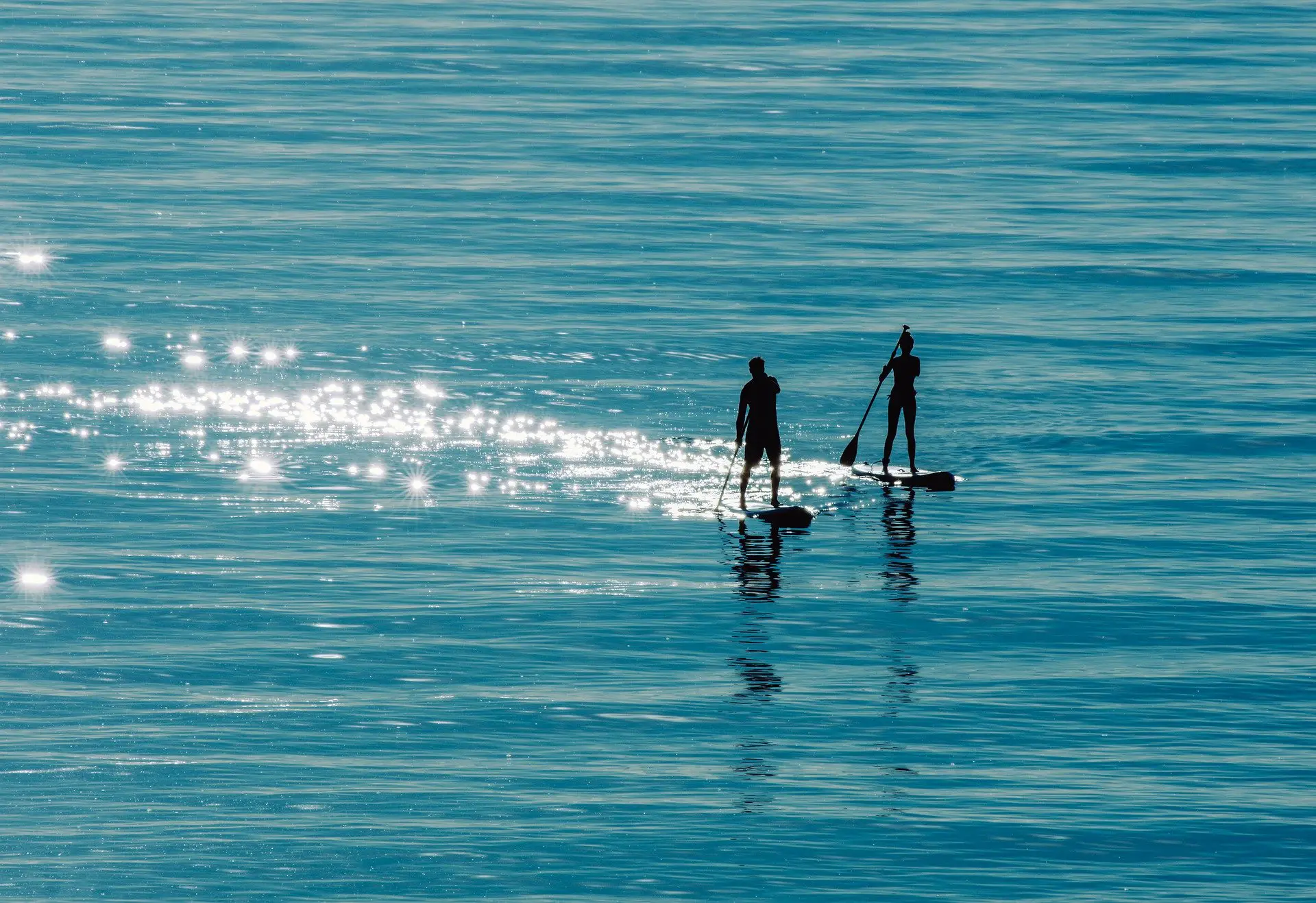Stand Up Paddle Board Tips – the fourth part of our “How to Stand Up Paddle Board”.
Learn the most essential things you need to know about SUP Paddle Board Technique.
In this 4th episode, we’ll show you you how to move forward really efficiently and quickly!
In this article, we show you everything necessary about the SUP Paddle Technique especially the types of Paddle Strokes which help you with manoeuvring:
- How can I keep the course?
- Is there a particular paddle stroke that helps me keep course more easily?
- How do I change Paddle Sites correctly?
- What options are there that help me manoeuvre my SUP Board?
We’ll show you here how you can steer your Stand Up Paddle Board and avoid too many changes to the paddle side. And we bring together what we’ve explained about the different standing positions on a SUP and how to paddle correctly.
So take 5 minutes…

Our Stand up paddle board technique graphics – to make it easily understandable
In order to explain the different techniques a little better, we will also use the following graphics in this section of the technique guide. These should help you to understand the descriptions in the instructions better.

Important Remarks:
In our stand up paddle instructions, we assume that you own or rent the required material. If not, check out our overview of boards and the Buying Guide!
As always, the “Safety Disclaimer” applies: stand up paddling is a water sport! You should, therefore, always adhere to the most important safety rules. If you do not know them yet, check them out quickly here.
The proper SUP paddle technique for travelling straight ahead
Even if you stroke the paddle straight and close to the board, that is, if you perform the paddle stroke perfectly, your board will not go straight ahead. This is simply because in the power phase, i.e., when you pull the paddle through, you propel the board slightly to the opposite side.
In this chapter, we will show you the 3 essential techniques that make travelling in a straight line possible.
Option 1: Change The Paddle Side
Indeed not an insider tip, and the most straightforward technique is to change sides every 3 – 5 paddle strokes.

Changing the paddle side then leads to pushing the SUP board again and again from the other side, thus keeping the course. With the paddle change, however, it is not possible to prevent small wavy lines. So you will not hold the course “perfectly” with this technique.
BUT:
The paddle change is undoubtedly the most straightforward technique for going straight ahead.
It also has another advantage:
By constantly changing the side, you avoid one-sided body loads and thus also overloads. So you stroke equally with both sides of your body.
How do you change the paddle side correctly?
The correct procedure for changing the paddle side is relatively simple:

- After the end of the power phase, you release the handle of the top hand
- The shaft hand guides the paddle towards the bow and diagonally over the board. The goal is for the paddle blade to reach the reach position on the other side of the board.
- While swinging the paddle, you grab it with your top hand (whose handle you have loosened), just below the shaft hand.
- Now, you loosen your upper hand (i.e., the shaft hand) and grab the top of the paddle.
If you follow this procedure, you will be able to continue with a full pull and power phase over the entire length immediately after changing the paddle side. This allows you to lose only minimal speed due to the evolving sides and makes your paddling more efficient altogether.
But there are also ways to stay the course without changing the paddle side. We’ll show you how to do that here.
Option 2: Edge load

If you want to travel straight ahead without regularly changing sides, you can play with the edge load.
But why would you steer with the edge load?
If the weight is shifted to one side of the board, then the board tilts slightly to the side with more weight; that is, it is somewhat deeper in the water on that side. Tilting also changes the angle of the fin and the keel of the board.
As a consequence, the board then steers to the side, which is deeper in the water (consequently to the side towards which you shift your weight).
This means:
if you now shift your weight slightly to the side on which you’re paddling, the rotation resulting from the pull of the paddle will be compensated.
As a result, the board moves straight ahead, even if you only paddle on one side.
How well this SUP paddling technique works, of course, also depends on the type and style of the board. For an all-round board in longboard or cruising style, however, it is ideal.
Of course, this technique also requires a little more practice. Until you can shift the weight evenly and control your movement while paddling to one side, you need to practice.
But once you have the trick of it, it makes stand up paddling even easier, and it is even possible to make slight curves on the paddle side without changing the paddle wildly back and forth.
Option 3: J-stroke

Another technique for travelling straight ahead without changing the paddle side is the so-called J-stroke.
You do not pull the paddle blade straight all the way past the board, but instead lead it away from the board at the end.
The primary sequence of movements is the same as the normal paddle stroke. However, you leave the paddle in the water a little longer, and, importantly, you pull it vigorously outwards with the shaft arm before retrieval (exit).
This kick to the outside should start at about foot level (i.e., about at the sweet spot). This gives the board an impulse behind the pivot point.
This turns the board slightly towards the paddle side and thus compensates for rotation with the paddle stroke. A clean, straight line is therefore possible.
This SUP paddling technique is especially helpful if you want to sprint or really bolt ahead.
You lose little speed with the J-stroke if it is executed correctly. And since you save yourself the side change, you can, of course, also paddle more quickly. But of course, you also put much more strain on one side of your body.
Conclusion and summary
For the training on the water, take the following important information from the graphic with you on the way:
The 3 Techniques for traveling straight ahead
Paddle site switch, edge load, J-stroke
Technique 1: Paddle Site Switch
Release your top hand during the exit. Guide the paddle forward diagonally over the board with your shaft hand towards the next catch position.
Grab the paddle with the “old” top hand below the shaft hand. Now loosen the “old” shaft hand and grab the paddle top. And off we go with the first stroke on the other side of the board.
Technique 2: Edge load
Shift your weight more to the side you’re paddling on.
Make sure you constantly immerse the paddle blade completely (i.e. until the transition between paddle blade and paddle shaft).
Controlling the edge load definitely requires the most practice with all variants.
Technique 3: J-stroke
In the last phase of the exit (at the level of your feet), you turn the paddle parallel to the edge of the board and push it away from the board.
This allows you to briefly push the board towards the paddle side and compensate for the movement of the board from the actual paddle stroke.
So now, you know everything you need to keep your board on track quickly and efficiently with the correct SUP paddling technique.
Off into the water!
HOW TO STAND UP PADDLE BOARD: WHERE YOU CAN FIND MORE ABOUT PADDLE BOARD TECHNIQUE
We hope that this overview of some of the basics of the SUP Paddle Technique will help you with your first excursions on the water.
And remember: Practice is key and even fun with SUP!
So off to the water and get wet! If you still want to know more about How to Paddle Board and SUP paddle techniques, take a deeper look at the other tips in our SUP Tips & Advice section.






